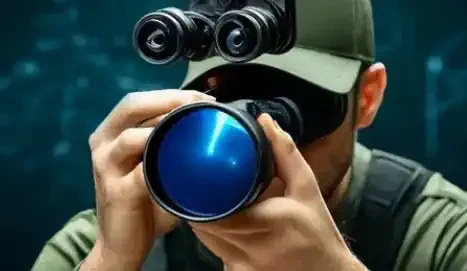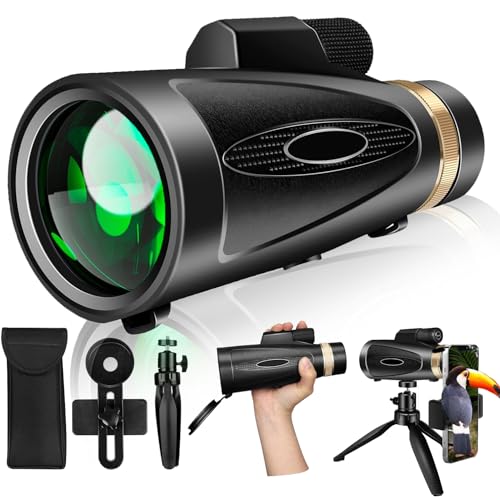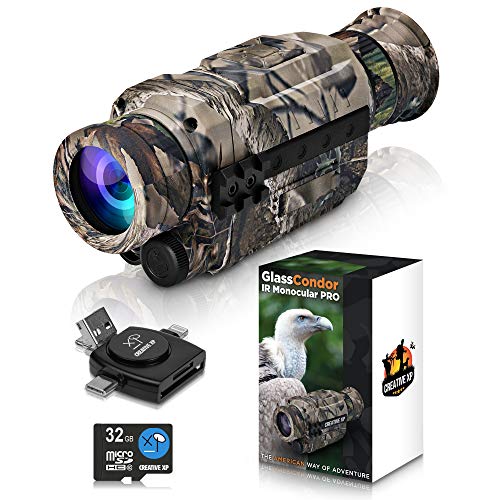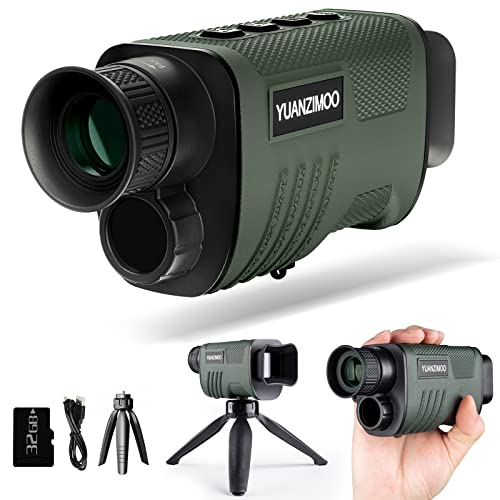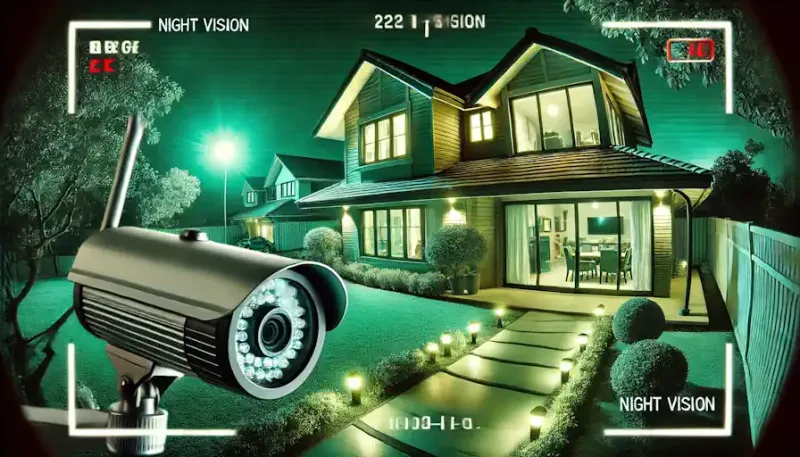Night Vision Monoculars: How They Work and Why You Need One
What are Night Vision Monoculars?
Night vision monoculars are sophisticated optical devices designed to amplify ambient light, including moonlight and starlight, to provide enhanced visibility in low-light conditions or complete darkness. Unlike binoculars or telescopes, which typically require both eyes to view images, monoculars offer single-eye viewing, making them compact and portable for various applications. Equipped with advanced technology, these devices are used in a wide range of fields, from military and law enforcement to outdoor recreation and wildlife observation.
Importance of Night Vision Technology
Night vision technology has revolutionized how humans perceive and navigate the darkness. By leveraging cutting-edge innovations in optics, electronics, and image processing, night vision devices enable individuals to see clearly in environments where natural vision would be severely limited or impossible. From enhancing safety and security to facilitating nighttime activities such as hunting, camping, and surveillance, the significance of night vision technology cannot be overstated.
Overview
In this comprehensive article, we will delve into the inner workings of night vision monoculars, exploring the fascinating technology behind these devices and elucidating why they are indispensable tools for anyone venturing into low-light environments. We will discuss the principles of night vision technology, elucidate how night vision monoculars function, highlight their myriad benefits, delve into practical applications across various industries, offer guidance on selecting the right monocular for your needs, provide tips for optimal usage, and present real-life scenarios showcasing the transformative impact of night vision technology.
Understanding Night Vision Technology
Night vision technology has evolved significantly since its inception, driven by advancements in optics, electronics, and image processing. In this section, we will embark on a journey through the history, principles, components, and types of night vision technology to gain a comprehensive understanding of how these remarkable devices operate.
History of Night Vision Devices
The roots of night vision technology can be traced back to the early 20th century, with notable developments occurring during World War II. Initially developed for military purposes, night vision devices were primarily used for surveillance and reconnaissance missions under cover of darkness. Over the decades, continuous research and innovation have led to significant improvements in image quality, size, and affordability, making night vision technology accessible to a broader audience beyond the military.
Principles Behind Night Vision Monoculars
At the heart of every night vision monocular lies a sophisticated optical system that harnesses the ambient light present in the environment. These devices utilize a process called image intensification to amplify incoming light photons, converting them into visible images that are then displayed to the user. The key principles governing this process include photoelectric effect, electron multiplication, and phosphor screen illumination, all of which contribute to the creation of clear and detailed imagery even in the darkest of nights.
Components of Night Vision Technology
Night vision monoculars comprise several essential components working in tandem to capture, amplify, and display images in low-light conditions. These components include an objective lens, image intensifier tube, eyepiece, power supply, and often an infrared illuminator for enhancing visibility in complete darkness. Each component plays a critical role in the overall functionality and performance of the device, with advancements in materials and manufacturing techniques continuously improving their efficiency and durability.
Types of Night Vision Generation
Night vision technology is classified into generations, each representing a significant leap forward in performance and capabilities. From the early analog systems of Generation 0 to the cutting-edge digital technology of Generation 4, each generation offers distinct advantages in terms of image quality, resolution, and sensitivity to light. Understanding the differences between these generations can help consumers make informed decisions when selecting a night vision monocular that best suits their needs and budget.
How Night Vision Monoculars Work
Night vision monoculars are marvels of modern technology, utilizing a complex interplay of optics, electronics, and image processing algorithms to transform darkness into vivid imagery. In this section, we will unravel the intricate workings of these devices, shedding light on the optical components, image intensification process, infrared illumination, and signal processing techniques that enable them to operate effectively in low-light conditions.
Optical Components
The optical system of a night vision monocular serves as the gateway through which ambient light enters and is manipulated to produce a visible image. At the forefront of this system is the objective lens, responsible for gathering incoming light from the surrounding environment and focusing it onto the image intensifier tube. The quality and precision of the objective lens directly impact the clarity and sharpness of the final image, making it a crucial component in the overall performance of the device.
Image Intensification Process
Central to the functionality of a night vision monocular is the image intensifier tube, a sophisticated electronic component that amplifies incoming light photons to create a brighter and more detailed image. This process begins with the conversion of incoming photons into electrons through a photocathode, followed by electron multiplication via a microchannel plate, and culminates in the creation of a visible image on a phosphor screen. The resulting image appears green due to the phosphor's spectral response and is perceived by the viewer through the eyepiece.
Infrared Illumination
While night vision monoculars can amplify ambient light to enhance visibility, they are limited in extremely low-light or no-light conditions. To overcome this limitation, many monoculars are equipped with built-in infrared illuminators that emit infrared light invisible to the human eye but detectable by the monocular's sensor. This infrared light serves as a supplementary source of illumination, allowing the device to produce clear images even in complete darkness. However, it's essential to note that the effectiveness of infrared illumination may vary depending on environmental factors such as humidity and atmospheric conditions.
Signal Processing
In addition to amplifying incoming light, night vision monoculars employ advanced signal processing algorithms to enhance image quality and reduce noise. These algorithms analyze the incoming image data, apply corrections for distortions and aberrations, and enhance contrast and sharpness to produce a clearer and more detailed final image. By leveraging the power of digital signal processing, modern night vision monoculars can deliver unparalleled performance in a variety of low-light conditions, ensuring optimal visibility and situational awareness for the user.
Benefits of Night Vision Monoculars
Night vision monoculars offer a multitude of advantages across various domains, ranging from enhancing safety and security to facilitating recreational activities and professional tasks in low-light environments. In this section, we will explore in detail the myriad benefits of incorporating night vision monoculars into your toolkit, including their role in enhancing nighttime visibility, safety and security applications, wildlife observation, and more.
Enhanced Nighttime Visibility
One of the primary benefits of night vision monoculars is their ability to extend human vision beyond the limitations of natural eyesight, allowing users to see clearly in conditions where darkness would otherwise obscure their surroundings. Whether navigating a dimly lit trail during a nighttime hike or conducting surveillance operations under the cover of darkness, night vision monoculars provide users with a distinct advantage by illuminating their surroundings and revealing hidden details that would otherwise go unnoticed.
Safety and Security Applications
Night vision monoculars play a crucial role in enhancing safety and security across various sectors, including law enforcement, military operations, and private security. By providing real-time visibility in low-light conditions, these devices enable security personnel to detect potential threats, monitor suspicious activities, and respond effectively to emergencies, thus safeguarding lives and property. Additionally, night vision monoculars are invaluable tools for search and rescue operations, enabling rescuers to locate and assist individuals in distress, even in remote or hazardous environments.
Wildlife Observation and Nature Exploration
For outdoor enthusiasts and nature lovers, night vision monoculars open up a world of nocturnal wonders, allowing them to observe wildlife behavior and natural phenomena that are often concealed by darkness. Whether tracking elusive nocturnal animals in their natural habitat or stargazing under the night sky, these devices provide a front-row seat to the captivating beauty of the nighttime world. Moreover, night vision monoculars enable researchers and conservationists to study nocturnal species and ecosystems with minimal disturbance, contributing to our understanding and preservation of biodiversity.
Recreational and Tactical Uses
Beyond practical applications, night vision monoculars offer recreational and tactical benefits for outdoor enthusiasts, hunters, and hobbyists. From exploring abandoned buildings and ghost towns under the veil of darkness to engaging in nighttime photography and astronomy, these devices add a sense of adventure and intrigue to recreational pursuits. Additionally, night vision monoculars are favored by hunters and marksmen for their ability to enhance target acquisition and accuracy in low-light conditions, increasing their effectiveness during dusk and dawn hunts.
Search and Rescue Operations
In emergency situations, every second counts, and having access to reliable night vision technology can mean the difference between life and death. Night vision monoculars empower search and rescue teams to locate missing persons, stranded hikers, or disaster survivors quickly and efficiently, even in the most challenging environments. By providing enhanced visibility in low-light conditions, these devices enable rescuers to cover larger areas in less time, improving the chances of a successful outcome and bringing hope to those in need.
Applications of Night Vision Monoculars
Night vision monoculars find extensive applications across a diverse range of industries and activities, leveraging their ability to provide enhanced visibility in low-light conditions. In this section, we will explore in-depth the practical uses and advantages of night vision monoculars in fields such as military and law enforcement, outdoor recreation, hunting, surveillance, and astronomy.
Military and Law Enforcement
Night vision monoculars have long been indispensable tools for military and law enforcement agencies worldwide, offering unparalleled advantages in nighttime operations. From conducting covert reconnaissance missions to executing precision strikes under the cover of darkness, these devices provide tactical superiority by enabling personnel to navigate and engage threats with enhanced situational awareness. Additionally, night vision monoculars aid in border patrol, surveillance, and hostage rescue operations, where visibility in low-light conditions is critical for mission success and personnel safety.
Outdoor Recreation and Adventure
For outdoor enthusiasts and adventurers, night vision monoculars unlock new possibilities for exploration and discovery in the nocturnal wilderness. Whether embarking on a nighttime hike, camping trip, or wildlife safari, these devices enhance the outdoor experience by revealing the hidden wonders of the nighttime world. From observing nocturnal animals in their natural habitat to stargazing under the expansive night sky, night vision monoculars add an element of excitement and intrigue to outdoor pursuits, allowing individuals to connect with nature in ways previously unimaginable.
Hunting and Shooting Sports
Hunters and shooting sports enthusiasts rely on night vision monoculars to level the playing field in low-light hunting conditions, where traditional optics may fall short. By amplifying ambient light and enhancing visibility, these devices enable hunters to track game more effectively, identify targets with greater precision, and make ethical shots with confidence. Additionally, night vision monoculars offer competitive advantages in nighttime shooting competitions, where accuracy and speed are paramount, giving participants an edge over their rivals and pushing the boundaries of marksmanship.
Surveillance and Monitoring
In the realm of surveillance and monitoring, night vision monoculars play a pivotal role in safeguarding assets, detecting intruders, and gathering intelligence in low-light environments. Whether deployed for perimeter security, property surveillance, or covert operations, these devices provide security personnel and law enforcement agencies with a discreet and effective means of monitoring activity day or night. With advanced features such as infrared illumination and digital recording capabilities, night vision monoculars offer comprehensive surveillance solutions tailored to the evolving needs of modern security environments.
Astronomy and Stargazing
Amateur astronomers and stargazing enthusiasts can also benefit from the use of night vision monoculars to explore the cosmos beyond the limitations of human vision. By amplifying faint starlight and celestial objects, these devices reveal intricate details of the night sky, allowing observers to observe distant galaxies, nebulae, and star clusters with unprecedented clarity. Whether observing the phases of the moon, tracking the movements of planets, or hunting for elusive deep-sky objects, night vision monoculars offer a unique perspective on the wonders of the universe, inspiring awe and curiosity in observers of all ages.
Choosing the Right Night Vision Monocular
Selecting the perfect night vision monocular can be a daunting task, given the plethora of options available on the market. In this section, we will provide an extensive guide to help you navigate through the myriad choices and make an informed decision based on your specific needs, preferences, and budget. From understanding key considerations to evaluating essential features and comparing different models, we'll equip you with the knowledge and insights necessary to find the ideal night vision monocular for your requirements.
Considerations Before Buying
Before diving into the world of night vision monoculars, it's essential to consider several factors that will influence your purchasing decision. First and foremost, assess your intended use-case scenarios and determine the primary purpose of the monocular, whether it's for recreational activities, professional tasks, or specialized applications such as hunting or surveillance. Additionally, consider environmental factors such as terrain, weather conditions, and lighting conditions prevalent in your typical operating environment, as these variables will impact the performance and suitability of the monocular.
Budgetary Factors
Night vision monoculars come in a wide range of prices, from budget-friendly entry-level models to premium high-end devices with advanced features. Establishing a realistic budget beforehand will help narrow down your options and prevent overspending on unnecessary features or specifications. While it's tempting to opt for the latest and most expensive model on the market, remember that the best value lies in finding a monocular that meets your specific requirements without breaking the bank. Strike a balance between performance, features, and affordability to ensure you get the most bang for your buck.
Key Features to Look For
When evaluating night vision monoculars, pay close attention to the following key features that can significantly impact performance and user experience:
Image Quality: Look for monoculars with high-resolution image sensors, superior optics, and advanced image processing algorithms to ensure crisp, clear, and detailed imagery.
Magnification: Consider the magnification power of the monocular, which determines how much closer objects appear relative to their actual size. Choose a magnification level appropriate for your intended use, balancing between zoom capability and field of view.
Range and Detection Distance: Assess the effective range and detection distance of the monocular, which dictate its ability to detect and identify objects at varying distances in low-light conditions. Opt for models with longer detection ranges for enhanced versatility and performance.
Durability and Build Quality: Evaluate the construction and materials used in the monocular to ensure durability, reliability, and resistance to environmental factors such as moisture, dust, and shock. Look for ruggedized designs and weatherproof seals for optimal performance in outdoor settings.
Battery Life: Consider the battery life of the monocular, especially if you anticipate extended periods of use without access to power sources. Look for models with long-lasting rechargeable batteries or compatibility with standard battery types for convenience and peace of mind.
Comparing Different Models
Once you've identified your requirements and budget constraints, it's time to research and compare different night vision monocular models available on the market. Take advantage of online reviews, manufacturer specifications, and user feedback to gather insights into each model's performance, features, and reliability. Pay attention to factors such as customer satisfaction ratings, warranty coverage, and after-sales support services offered by manufacturers or retailers. Consider creating a comparison chart or spreadsheet to organize and compare key attributes of each model, facilitating an informed decision-making process.
Tips for Using Night Vision Monoculars Effectively
While night vision monoculars are powerful tools for enhancing visibility in low-light conditions, maximizing their effectiveness requires proper understanding and utilization. In this section, we will provide a comprehensive guide comprising practical tips and techniques to help you make the most out of your night vision monocular. From handling and maintenance to adjusting for optimal performance and understanding limitations, these tips will ensure you get the best results from your device in any situation.
Proper Handling and Maintenance
Proper handling and maintenance are crucial for ensuring the longevity and performance of your night vision monocular. To minimize the risk of damage or malfunction, follow these guidelines:
Handle the monocular with care, avoiding rough handling or impact that could damage sensitive components.
Store the monocular in a protective case when not in use to shield it from dust, moisture, and accidental damage.
Clean the lens and eyepiece regularly using a soft, lint-free cloth to remove dust, fingerprints, and smudges that may impair visibility.
Avoid exposing the monocular to extreme temperatures or humidity levels, as prolonged exposure could damage internal components or affect performance.
Adjusting for Optimal Performance
Achieving optimal performance from your night vision monocular requires proper adjustment and calibration to suit your specific viewing conditions. Follow these steps to adjust your monocular for optimal performance:
Adjust the focus ring or diopter setting to achieve a sharp and clear image according to your eyesight.
Adjust the gain or brightness settings to optimize image brightness and contrast for your viewing environment.
Experiment with different magnification levels and field of view settings to find the most comfortable and effective viewing configuration.
Fine-tune the infrared illuminator settings, if available, to match the ambient light conditions and enhance visibility in low-light or no-light environments.
Understanding Limitations
While night vision monoculars offer significant advantages in low-light conditions, it's essential to recognize their limitations and adjust your expectations accordingly. Keep the following limitations in mind when using your night vision monocular:
Limited Range: Night vision monoculars have a finite detection range, beyond which objects may appear blurry or indistinct. Avoid relying on your monocular for long-distance observation beyond its effective range.
Reduced Performance in Adverse Conditions: Extreme weather conditions such as fog, rain, or snow can impair the performance of night vision monoculars by scattering or absorbing light. Exercise caution and avoid exposing your monocular to harsh environmental conditions that could compromise visibility.
Vulnerability to Bright Light Sources: Excessive exposure to bright light sources such as headlights, flashlights, or direct sunlight can damage the sensitive components of your night vision monocular. Take precautions to shield the lens and avoid prolonged exposure to intense light sources.
Safety Precautions
When using night vision monoculars, it's essential to prioritize safety and take precautions to prevent accidents or injuries. Follow these safety guidelines to ensure a safe and enjoyable experience:
Avoid looking directly at bright light sources or laser pointers with your night vision monocular, as this could cause discomfort or damage to your eyes.
Use caution when navigating uneven terrain or unfamiliar environments at night, as reduced depth perception and peripheral vision may increase the risk of trips, falls, or collisions.
Be mindful of your surroundings and maintain situational awareness at all times, especially in low-light conditions where potential hazards may be less visible.
Familiarize yourself with the proper operation and handling of your night vision monocular before venturing into the field, and practice using it in controlled environments to build confidence and proficiency.
By following these tips and precautions, you can ensure safe, effective, and enjoyable use of your night vision monocular in any situation.
Real-Life Scenarios: How Night Vision Monoculars Make a Difference
Beyond the technical specifications and theoretical applications, the true value of night vision monoculars lies in their ability to make a tangible difference in real-world scenarios. In this section, we will delve into various real-life situations and case studies where night vision monoculars have played a pivotal role in enhancing safety, enabling rescue operations, and facilitating successful outcomes in diverse environments and industries. Through these firsthand accounts and testimonials, we aim to illustrate the transformative impact of night vision technology on individuals, organizations, and communities worldwide.
Testimonials and User Experiences
The most compelling evidence of the efficacy and utility of night vision monoculars comes from the individuals who have used them firsthand in various contexts and environments. In this subsection, we will showcase testimonials and user experiences shared by individuals from different walks of life, highlighting the practical benefits and applications of night vision technology in their daily activities, professional duties, and recreational pursuits. From law enforcement officers and military personnel to outdoor enthusiasts and wildlife photographers, these firsthand accounts offer valuable insights into the real-world effectiveness of night vision monoculars across diverse scenarios and use cases.
Case Studies
In addition to individual testimonials, case studies provide detailed analyses of specific incidents or operations where night vision monoculars played a critical role in achieving successful outcomes. In this subsection, we will present a selection of compelling case studies from various industries and sectors, ranging from search and rescue missions and law enforcement operations to wildlife conservation efforts and outdoor adventures. Each case study will examine the unique challenges faced, the role of night vision technology in addressing those challenges, and the resulting impact on safety, efficiency, and mission success. By dissecting these real-life scenarios, we aim to demonstrate the practical relevance and effectiveness of night vision monoculars in solving complex problems and achieving positive outcomes in diverse environments and situations.
Success Stories
Finally, success stories provide inspiring examples of how night vision technology has empowered individuals and organizations to overcome obstacles, accomplish goals, and make a positive difference in the world. In this subsection, we will highlight notable success stories and achievements made possible through the use of night vision monoculars, whether it's locating missing persons in remote wilderness areas, apprehending suspects in covert operations, or capturing breathtaking wildlife footage in the dead of night. By celebrating these success stories, we aim to showcase the incredible capabilities and transformative potential of night vision technology in enhancing human performance, expanding horizons, and pushing the boundaries of what is possible.
Through testimonials, case studies, and success stories, we will paint a vivid picture of how night vision monoculars have made a tangible difference in real-world scenarios, inspiring confidence, enabling success, and saving lives in the process.
Conclusion
As we conclude our exploration of night vision monoculars and their myriad applications, it's evident that these remarkable devices have revolutionized how we perceive and navigate the darkness. From their humble origins in military reconnaissance to their widespread adoption in civilian and commercial sectors, night vision monoculars have become indispensable tools for enhancing visibility, improving safety, and enabling success in low-light environments.
Recap of Key Points
Throughout this article, we have delved into the inner workings of night vision monoculars, unraveling the intricate technology that enables them to amplify ambient light and transform darkness into vivid imagery. We've explored the principles of image intensification, the role of infrared illumination, and the importance of signal processing in creating clear and detailed images in low-light conditions. Additionally, we've examined the benefits of night vision monoculars across various domains, from military and law enforcement to outdoor recreation and wildlife observation.
Final Thoughts
As we reflect on the myriad applications and benefits of night vision monoculars, it's clear that these devices have transcended their initial military origins to become indispensable tools for a wide range of users. Whether it's enhancing safety and security, enabling nighttime adventures, or unlocking the mysteries of the nocturnal world, night vision monoculars empower individuals and organizations to see and achieve more in the dark.
Encouragement to Explore Night Vision Technology
As technology continues to evolve and improve, the future of night vision technology holds even greater promise for innovation and advancement. From enhanced image resolution and sensitivity to new form factors and integrated features, the possibilities for night vision monoculars are endless. We encourage readers to explore the world of night vision technology further, whether through research, experimentation, or hands-on experience, to discover the countless ways in which these devices can enrich their lives and broaden their horizons.
In conclusion, night vision monoculars represent a powerful intersection of science, technology, and human ingenuity, offering a glimpse into the unseen world of the night and empowering users to venture forth with confidence into the darkness.
